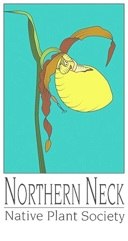Plant of the Month December 2021: American Mistletoe
American Mistletoe, Phoradendron leucarpum
Northern Neck Chapter, Virginia Native Plant Society
December 2021 Plant of the Month
By Betsy Washington
The evergreen leaves and winter fruit of American Mistletoe (photo by Betsy Washington)
The December Plant of the Month, American Mistletoe, goes by several common names - American, Eastern, Oak, False, or Hairy Mistletoe. This evergreen shrub grows high in the branches of deciduous trees where it is most visible in winter after the leaves fall. While not a plant you would “plant” in your garden, it has a fascinating history centered around the holidays and winter solstice. Many are familiar with its use as part of the Christmas tradition of kissing beneath a sprig of mistletoe, however its use dates back at least to ancient Druid, Roman, and Norse mythology where evergreen mistletoe was considered sacred and used in winter solstice celebrations. It was long considered “a miracle plant that could heal all maladies and protect people, keeping them safe from harm”. In ancient Greek mythology it was associated with fertility and vitality, and Native Americans used it to treat paralysis, headaches, and as a contraceptive. The name Mistletoe itself is intriguing and derives from an Anglo-Saxon word “mistel tan” (mistel meaning dung and tan meaning twig) or “Dung on a Twig’ referring to the dung “pooped” out by birds on twigs high in the canopy from which seeds seemed “to spontaneously grow”.
The ecology of this curious evergreen shrub that grows high in the branches of trees is as intriguing as the many myths associated with it. While there are hundreds of species of mistletoe worldwide, our American Mistletoe occurs in eastern North American from N. J. to Ohio south to Florida and Texas and Mexico, typically growing high on the branches of deciduous trees, especially Oaks, Red Maples, and Black Gums. Although it occurs over much of Virginia, it is most common in the Coastal Plain where it is usually found in wet habitats such as swamp forests. While Mistletoe has green leaves with chlorophyll and gets part of its nutrients from photosynthesis like other plants, it is also considered a “hemi-parasite”. Mistletoe actually “roots” in the tree branch itself with special structures (haustoria) that penetrate the bark of a host tree and connect with its xylem (plumbing system), tricking the host tree into supplying it with water and minerals. In fact, the genus name, Phoradendron, means “tree-thief”.
Mistletoe grows with a single “trunk” forming a dense rounded “sub-shrub” high in boughs of trees and can reach up to 3’ in diameter but is often less than 12” across. It has leathery oblong evergreen leaves arranged opposite each other along stout green stems. The flowers usually bloom in fall and are small, inconspicuous, and greenish yellow with no true petals. These are followed by distinctive, translucent white, round berries up to ¼” wide, containing a small seed. This seed will not germinate on the ground but only on a tree branch and has adapted to do so by being surrounded by a very sticky goo or juice. The berries provide an important winter food source for a variety of songbirds including cedar waxwings, eastern bluebirds, and thrushes. The birds relish the berries and afterwards excrete the sticky goo and seeds in their excrement, which adhere to the bare branches allowing the seeds to germinate. Research has shown the sticky seeds will stick to the bird’s bills and, as you may have observed, birds often wipe off their bills on a branch, and that sticky seed has been planted, so to speak. While the fruit is a vital songbird food, the berries are toxic to humans and pets, so please don’t taste those berries, but you would have to be eat large quantities to cause intestinal distress, vomiting, and low blood pressure.
There has been some debate in the scientific community about how much Mistletoe harms their host trees as they tap into the xylem and extract minerals and water, sometimes causing branch die-back, but they usually do not occur in densities that cause serious harm. Several recent studies of various mistletoe species have recognized mistletoe as a “keystone” species providing important ecosystem services to the forests where they occur. The leaf litter, fruit, and other organic matter create important habitat and drop to the ground below enriching the soils with nutrients, while the flowers supply a variety of small insects, bees, and wasps with pollen and nectar, and the fruit provides critical winter food for a number of birds. Additionally, it is the only known host for the caterpillars of the Great Purple Hairstreak (Altides halesus) – a stunningly beautiful butterfly that anyone would feel lucky to attract to their gardens! The National Wildlife Federation says, “It is not unheard of to find that the total number of organisms in a mistletoe-infested woodland outnumbers the population of a mistletoe-free forest by as much as three times”.
If you are lucky enough to have Mistletoe on your property, get out and celebrate the winter solstice, your good luck, and maybe even catch a kiss under the mistletoe. Happy Holidays and Winter Solstice to everyone.
Purple Hairstreak butterfly Mistletoe growing in a Black Gum tree
(Photo by Betsy Washington)
Purple Hairstreak butterfly
mistletoe is the only known host plant
(Photo by Kevin Howe)
Mistletoe growing in a Black Gum tree
(Photo by Betsy Washington)



